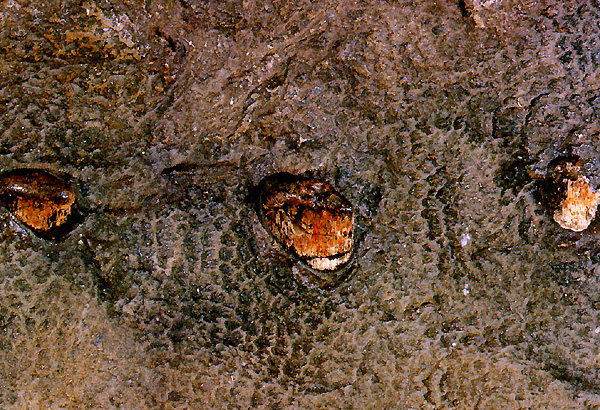Saurolophus angustirostris
 Saurolophus angustirostris -Rozhdestvensky, 1957- skeleton
Saurolophus angustirostris -Rozhdestvensky, 1957- skeleton
Archosauria: Ornithischia: Ornithopoda: Hadrosauridae
Locality: Altan Ula, Nemegt Basin, Gobi Desert, southern Mongolia
Age: Late Cretaceous (Late Campanian-Early Maastrichtian), 74 million years ago
Meaning of name: "ridged or crested reptile"
Size: 10 meters long
 Saurolophus angustirostris -Rozhdestvensky, 1957- lower jaw
Saurolophus angustirostris -Rozhdestvensky, 1957- lower jaw
 Saurolophus angustirostris -Rozhdestvensky, 1957- fragment of fossil skin
Saurolophus angustirostris -Rozhdestvensky, 1957- fragment of fossil skin
 Nest of hadrosaur eggs
Nest of hadrosaur eggs
Saurolophus is one of the largest hadrosaurids, or duck-billed
dinosaurs. The toothless anterior parts of the jaws in Saurolophus were flattened and
widened, like a duck bill. At the same time, the numerous lateral teeth were well
developed, so the animal could cut and chew very effectively aquatic vegetation which
was probably its regular forage. Indeed, both the vertically-flattened tail and wide paws
suggest that Saurolophus might dwell in shoals and coastal environments. The posterior
part of the skull roof in Saurolophus forms a long backward directed spine with inner
hollows connected to aerial ducts. Many dinosaurologists think these hollows might be
acoustic resonators, that could reinforce vocalisation in Saurolophus and other species of
the hadrosaurids. Relatively well-developed fore limbs in Saurolophus suggests it might
be quadrupedal when moving slowly, but could take bipedal stance when travelling faster.
Saurolophus is also well known in North America. There, as in Mongolia, it is common in
flood plain deposits. Although not the largest hadrosaur or duck-billed dinosaur (that
honour goes to Shantungosaurus giganteus from China) Saurolophus angustirostris was
still one of the biggest.
For some reason, skin impressions of hadrosaurs are rather common both in North America
and Central Asia. They show that these animals had a scale pattern typical of reptiles.
There is no suggestion of hair, feathers, or any other insulating external body covering.
Saurolophus had a horny beak that lacked any teeth with a battery of cheek teeth good
for processing resistant vegetation. The outside three fingers of the hand were joined in
a fleshy 'mitten' and the two inner fingers had sizeable, stout claws. The skull bones at
the back of the head formed a spike which continued behind the head. The back was
stiff because of the bony tendons that criss-crossed between the neural spines of
the vertebrae, and the tail was flattened from the sides. Paleontologists think that
Saurolophus spent part of the time walking as a quadraped on four legs, while at other
times, perhaps when travelling fast, walking upright on its hind legs only. The
flattened tail and the paddle-like hands suggest that this duck-billed hadrosaur
spent part of its life in water.
|